As the landscape of online retail continues to evolve, the dropshipping model has emerged as a game-changer for entrepreneurs seeking a low-risk, high-reward entry into the market. Starting a dropshipping business can be easy with the guide and courses available.
In the blog, we’ll navigate through the fundamental steps, strategies, and considerations that will set the foundation for your success in the world of dropshipping. From selecting the right niche to building a user-friendly online store, and from forging strong partnerships with reliable suppliers to implementing effective marketing strategies, we’ll cover every aspect of launching and growing a thriving dropshipping business.
What is Dropshipping?
Dropshipping is a modern and innovative retail fulfillment method that allows entrepreneurs to sell products without the need to handle inventory or manage the complexities of order fulfillment. In a traditional retail model, a business purchases products in bulk, stores them in a warehouse and then ships them to customers upon purchase. However, dropshipping flips this model on its head.
In a dropshipping setup, the retailer doesn’t stock any products. Instead, when a customer makes a purchase, the product is shipped directly from the supplier or manufacturer to the customer. This means that the retailer never sees or handles the product physically. The entire process is streamlined. This makes it a popular choice for aspiring entrepreneurs and small businesses looking to enter the e-commerce space without a significant upfront investment.
The workings of dropshipping are relatively straightforward. A retailer sets up an online store, selects products from suppliers, and lists them for sale. When a customer places an order, the retailer purchases the product from the supplier, who then ships it directly to the customer. The retailer makes a profit by selling the product at a higher price than the cost from the supplier. The difference serves as the profit margin.
One of the key advantages of dropshipping is the low barrier to entry. Without the need to invest in inventory, storage, and shipping infrastructure, entrepreneurs can focus on building and marketing their online stores. Additionally, dropshipping allows for a wide range of products to be offered without the risk of unsold inventory, providing flexibility and scalability.
However, dropshipping is not without its challenges. Since retailers have little control over inventory and order fulfillment, issues like product availability, shipping times, and product quality become critical. Effective communication and collaboration with reliable suppliers are crucial for a successful dropshipping business.
Why It’s Worth Starting a Dropshipping Business
Starting a dropshipping business can be a lucrative and rewarding venture for aspiring entrepreneurs. It offers a host of benefits that make it worth considering. One of the primary advantages is the low financial barrier to entry. Unlike traditional retail models that require substantial investments in inventory, storage, and logistics, dropshipping allows entrepreneurs to start their online stores with minimal upfront costs. This makes it an attractive option for those looking to test the waters of e-commerce without a significant financial commitment.
Flexibility
Another compelling reason to start a dropshipping business is the flexibility it offers. With no need to manage inventory or handle shipping logistics, entrepreneurs can focus on building their brands, marketing their products, and refining their online presence. This flexibility is particularly advantageous for individuals with limited time or those looking to run a side business alongside other commitments.
The wide variety of products available for dropshipping is another appealing aspect. Entrepreneurs can curate a diverse product range without the risk of being stuck with unsold inventory. This allows for experimentation with different niches and markets. It enables entrepreneurs to adapt and pivot based on consumer trends and demands.
Scalability
Scalability is a key feature of dropshipping that shouldn’t be overlooked. As the business grows, there’s no need to worry about expanding warehouse space or managing increased inventory levels. The scalability of dropshipping allows entrepreneurs to focus on scaling their marketing efforts and expanding their product offerings without the logistical challenges associated with traditional retail.
Global Reach
Moreover, the global reach of dropshipping is a game-changer. Since products are shipped directly from suppliers to customers, there are no geographical constraints. Entrepreneurs can target a global audience without the need for complex international shipping arrangements. It opens up new markets and opportunities for growth.
However, it’s essential to acknowledge the challenges that come with dropshipping, such as potential issues with product quality, longer shipping times, and dependency on suppliers. Successful dropshipping requires careful research, strategic planning, and the cultivation of reliable supplier relationships. Despite these challenges, the benefits of low risk, flexibility, scalability, and global reach make starting a dropshipping business a compelling option for many aspiring entrepreneurs.
7 Steps to Start a Dropshipping Business
Starting a dropshipping business is not hard with the availability of the platforms that simplify the process.
1. Start With Selecting a Niche – Start a Dropshipping Business
Choosing the right niche is a critical first step in launching a successful dropshipping business. The niche you select will influence your target audience, the types of products you offer, and the level of competition you face.
Begin with Passion and Interest
One of the most effective ways to choose a niche is by exploring your own passions and interests. You should consider the topics and products that genuinely excite you. When you’re passionate about the niche, you’re more likely to stay motivated and engaged in your business.
Moreover, your enthusiasm can be contagious, resonating with potential customers who share similar interests. This alignment between your personal passions and your business can set the foundation for a sustainable and fulfilling venture.
Research Market Demand
While personal interest is crucial, it’s equally important to assess the market demand for your chosen niche. You can use tools like Google Trends, keyword research, and industry reports to gauge the popularity and growth potential of different niches.

Also, look for niches with a steady or rising demand and avoid those that are oversaturated or experiencing a decline. A balance between personal interest and market demand can help you identify a profitable niche that aligns with your business goals.
Analyze Competition
Understanding the competitive landscape is key to making informed decisions about your niche. You should conduct a thorough analysis of other dropshipping businesses operating in your chosen niche. You can assess the number of competitors, their strengths and weaknesses, and the strategies they employ.
Then, look for gaps or areas where you can differentiate your business. While some competition is healthy, entering a niche with extremely high competition might make it challenging to establish your brand and capture market share.
Consider Profitability and Product Range
Evaluate the potential profitability of your chosen niche by analyzing the average product prices, profit margins, and shipping costs. You may look for products that have a reasonable markup while remaining competitive in the market.
Additionally, consider the range of products within your chosen niche. A diverse product range allows you to cater to a broader audience and increases the chances of attracting repeat customers. Ensure that your niche offers a balance between profitability and a variety of products that appeal to your target market.
2. Analyze the Market – Start a Dropshipping Business
Analyzing the market is a crucial step in launching a successful dropshipping business. A comprehensive understanding of market dynamics, consumer behaviour, and competition is essential for making informed decisions and devising effective strategies. Here’s a detailed guide on how to analyse the market for your dropshipping business.
Conduct Market Research
Begin by conducting thorough market research to gain insights into industry trends, consumer preferences, and potential opportunities.
You can utilize online tools and platforms like Google Trends, industry reports, and social media analytics to identify popular products and emerging niches. Look at the niche that you are interested in and see the latest search trend.
Analyzing market trends will help you make informed decisions about the types of products you want to offer and the target audience you aim to reach.
Evaluate Consumer Demand
Understanding consumer demand is a key aspect of market analysis. You need to identify products that are in high demand and have the potential for sustained interest. Tools like keyword research and search engine optimization (SEO) can help you gauge the volume of online searches for specific products.
Additionally, analyze customer reviews on popular e-commerce platforms to identify any pain points or unmet needs in the market. By aligning your product offerings with consumer demand, you increase the likelihood of attracting and retaining customers.
Assess Competition
A thorough analysis of the competitive landscape is crucial for positioning your dropshipping business effectively. You can identify key competitors in your chosen niche and analyze their strengths, weaknesses, and unique selling propositions.
Also, you should evaluate their pricing strategies, customer reviews, and marketing tactics. Identifying gaps or areas where competitors fall short can present opportunities for differentiation and improvement. Strive to offer a unique value proposition that sets your business apart from others in the market.
You can do this by looking at different marketplaces or social media to see what others are selling. Then, compare their pricing and marketing strategy.
Consider Market Saturation and Trends
Evaluate the level of market saturation in your chosen niche. While competition is normal, entering an oversaturated market may pose challenges in establishing your brand and gaining market share.
Additionally, stay attuned to industry trends and advancements in technology. Anticipating and adapting to market trends can give your dropshipping business a competitive edge. Stay informed about changes in consumer behaviour, preferences, and emerging technologies that may impact your chosen market.
3. Select a Supplier – Start a Dropshipping Business
Selecting the right supplier is a critical aspect of building a successful dropshipping business. Your supplier’s reliability directly impacts the quality of products, shipping times, and overall customer satisfaction. Here’s a guide on how to choose a supplier for your dropshipping business.
Research and Reputation
Start by researching potential suppliers thoroughly. Look for suppliers with a positive reputation for product quality and reliability. You can utilize online reviews, testimonials, and ratings to gauge the experiences of other businesses that have partnered with the supplier.
A reliable supplier should have a track record of timely deliveries, consistent product quality, and excellent customer service. Printify, for example, is known for its extensive network of print providers. It allows businesses to create and sell custom products without the hassle of inventory management.
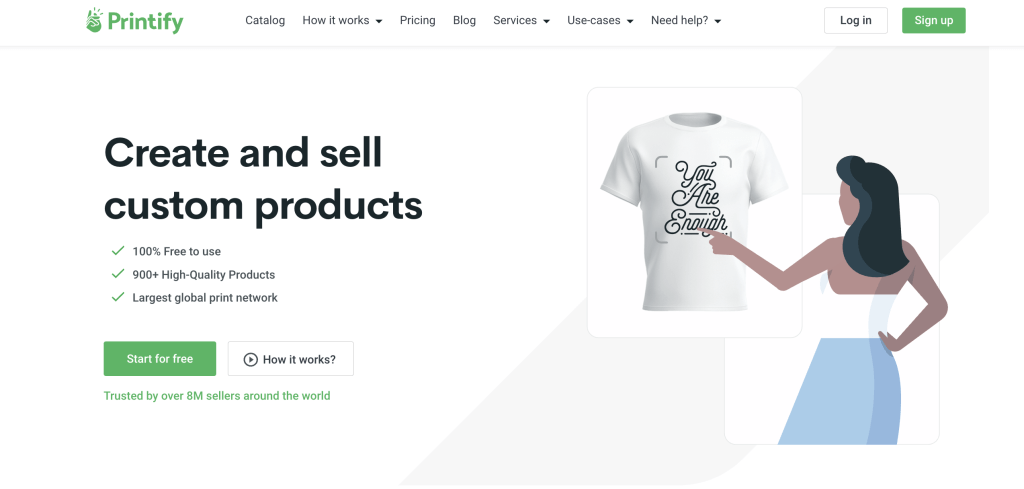
Product Range and Customization Options
Consider the product range and customization options offered by the supplier. Depending on your niche and target audience, you’ll want a supplier that can provide a diverse range of products that align with your brand.
Printify, for example, specializes in print-on-demand products, enabling businesses to create custom designs for items such as apparel, accessories, and home goods. The ability to offer a variety of products allows for greater flexibility and the opportunity to cater to different customer preferences.
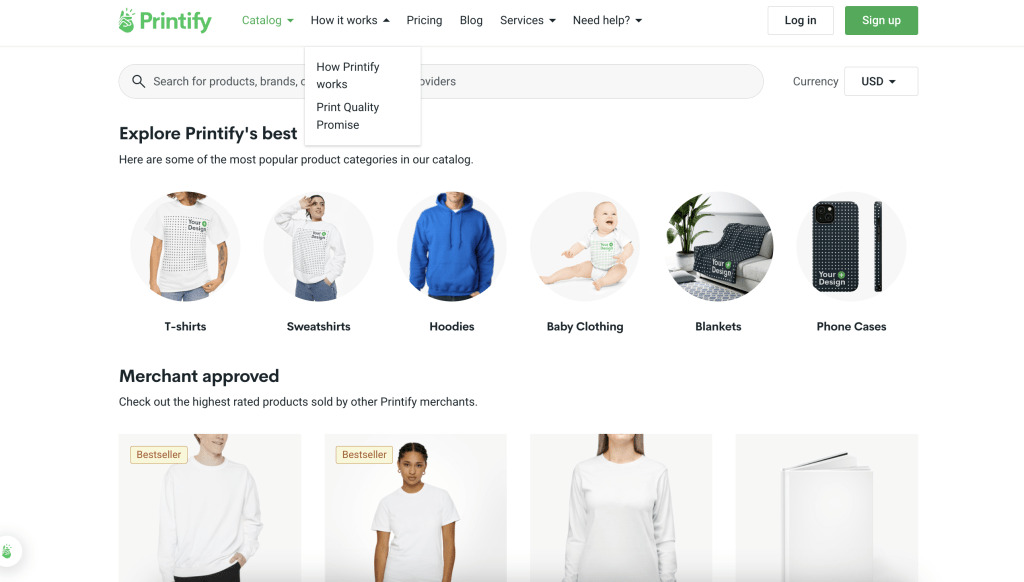
Shipping Times and Costs
Evaluate the shipping times and costs associated with each potential supplier. Customers appreciate quick and reliable shipping, so choosing a supplier with reasonable shipping times is crucial for customer satisfaction.
Additionally, transparent shipping costs help you calculate your overall expenses and set appropriate product prices. Printify connects businesses with a network of print providers worldwide, allowing for efficient shipping to various regions. Be sure to communicate with the supplier to understand their shipping processes and any potential delays.
Integration and Ease of Use
Consider the ease of integration with your chosen supplier. A user-friendly interface and seamless integration with your e-commerce platform can save you time and effort. Printify integrates with popular platforms like Shopify, WooCommerce, and Etsy, making it easy for businesses to set up and manage their print-on-demand products. Integration streamlines order processing, inventory management, and other essential tasks. It provides a smoother experience for both you and your customers.
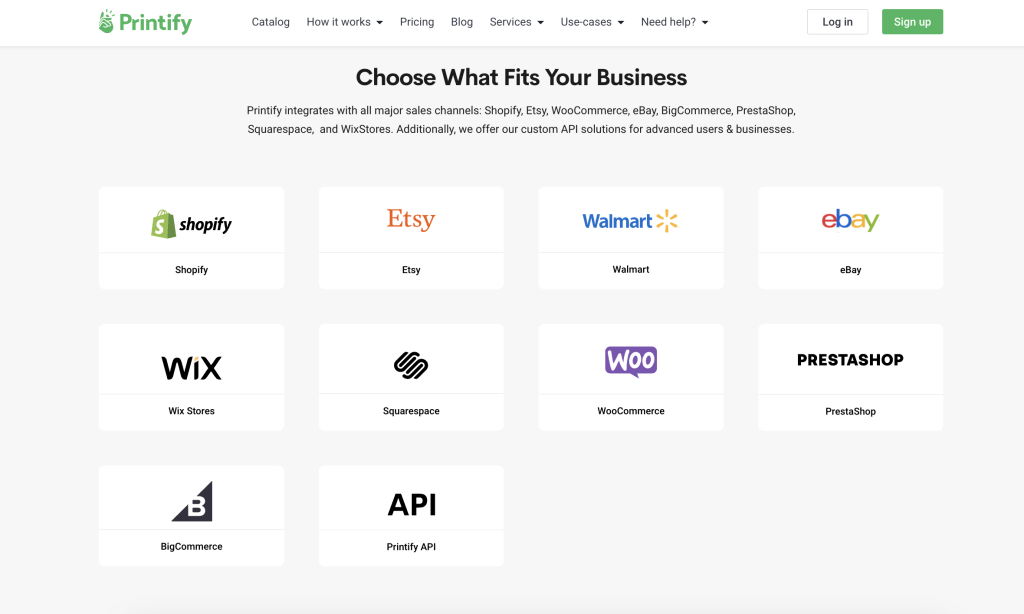
Printify Dropshipping and Print-On-Demand Supplier
Printify stands out as an excellent choice for dropshipping due to its comprehensive and user-friendly platform that seamlessly connects businesses with a vast network of reliable print providers.
One of the key advantages of Printify is its extensive product range, allowing entrepreneurs to offer a diverse array of customizable items, from apparel and accessories to home goods. This versatility enables businesses to cater to a wide range of customer preferences and niches. The platform’s commitment to quality is reflected in its stringent supplier selection process, ensuring that businesses can partner with reputable providers known for delivering high-quality products.
Additionally, Printify’s integration with popular e-commerce platforms, including Shopify, WooCommerce, and Etsy, streamlines the entire dropshipping process, making it easy for entrepreneurs to set up, manage, and scale their businesses with efficiency. With transparent shipping information, competitive pricing, and a reputation for reliability, Printify emerges as a go-to solution for those seeking a hassle-free and robust print-on-demand dropshipping experience.
Browse the Printify Product catalogue
4. Decide Where to Sell – Start a Dropshipping Business
Deciding where to sell your dropshipping products is a crucial decision that can significantly impact the success of your business. Considerations such as your target audience, product niche, and platform features all play a role in determining the most suitable marketplace for your dropshipping venture.
Understand Your Target Audience
Different platforms attract distinct demographics, and your ideal customers may have preferences for specific online marketplaces. If your products cater to a younger, tech-savvy audience, platforms like Shopify or Instagram may be more effective.
On the other hand, if your target market is diverse and broad, marketplaces like Amazon or eBay could provide exposure to a wider range of potential customers.
Evaluate the Platform Features
Each e-commerce platform comes with its unique features and limitations. Assess the tools and functionalities offered by potential platforms to determine which aligns best with your business needs.
For instance, Shopify provides a user-friendly interface and a range of customizable templates, while Amazon offers a massive customer base but comes with strict regulations. When choosing the platform, you should consider factors such as ease of use, payment gateways, and available integrations to ensure a seamless and efficient selling experience.
Research Fees and Costs
Understanding the fee structures of different platforms is crucial for managing your dropshipping business’s profitability. Firstly, you need to evaluate the listing fees, transaction fees, and any other costs associated with each platform.
While some platforms might charge higher fees, they may offer a larger customer base and additional marketing opportunities. Weigh the costs against the potential benefits and choose a platform that aligns with your budget and revenue goals.
Build a Multi-Channel Strategy
Instead of limiting your dropshipping business to a single platform, consider implementing a multi-channel strategy. Selling on multiple platforms diversifies your reach and minimizes the impact of potential disruptions on a single channel. Utilize social media platforms, online marketplaces, and your own e-commerce store to create a well-rounded approach.
Selling on Etsy
Etsy is a popular choice for dropshipping businesses, especially those focusing on handmade, vintage, or unique products. With a community that values craftsmanship and creativity, Etsy provides a platform for sellers to connect with buyers seeking one-of-a-kind items.
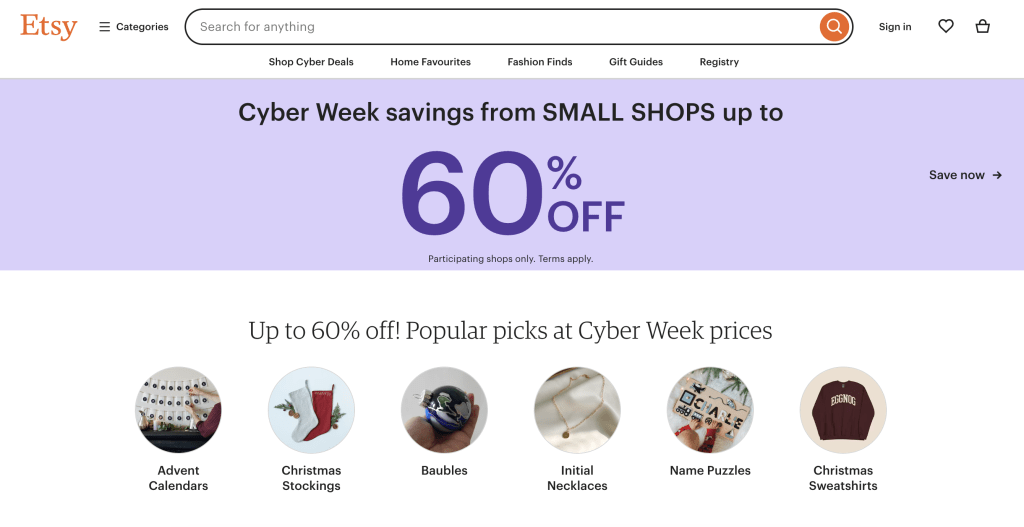
Setting up a shop on Etsy is relatively straightforward, and the platform’s emphasis on visually appealing listings aligns well with the aesthetic nature of many dropshipped products. Etsy’s built-in audience can be advantageous for reaching customers interested in artisanal and personalized goods.
However, it’s essential to navigate Etsy’s fee structure, which includes listing fees, transaction fees, and payment processing fees, to ensure profitability for your dropshipping business.
Selling on Shopify
Shopify is a versatile and robust e-commerce platform that has gained immense popularity among dropshippers for its user-friendly interface and extensive customization options. Entrepreneurs appreciate Shopify’s flexibility, allowing them to create branded, professional-looking stores without the need for extensive coding knowledge.

The platform supports a wide range of apps and plugins, making it easy to integrate with various dropshipping tools, including Printify and Printful. While Shopify does have subscription fees, the scalability and control it offers over your store’s design and functionality. Furthermore, branding makes it an attractive choice for those looking to build a unique and independent online presence.
Start Selling on Shopify with a Free Trial
Selling on ClickFunnels
ClickFunnels offers a different approach to selling compared to traditional e-commerce platforms. It is renowned for its focus on creating sales funnels — a series of steps designed to guide potential customers toward a conversion.

While not typically used for traditional product listings, ClickFunnels is effective for selling through a sales funnel model, particularly for informational products, courses, or high-ticket items. It provides tools for building landing pages, order forms, and upsell sequences.
ClickFunnels can be a valuable addition to your dropshipping strategy, especially if you plan to employ a direct-response marketing approach. However, it’s crucial to understand that ClickFunnels is more suited for specific sales strategies and may require a different marketing approach compared to platforms like Etsy or Shopify.
Start ClickFunnels with 14-day Free Trial
5. Set up the Payment Options – Start a Dropshipping Business
Setting up efficient and secure payment options is a crucial aspect of establishing a successful dropshipping business. The payment process directly influences customers’ trust and satisfaction, impacting the overall success of your venture. Here’s a comprehensive guide on how to set up payment options for your dropshipping business.
Choose Reliable Payment Gateways
Selecting reputable payment gateways is paramount to ensure smooth and secure transactions. Popular payment processors like PayPal and Stripe are widely trusted and offer a range of features to safeguard both your business and your customers.
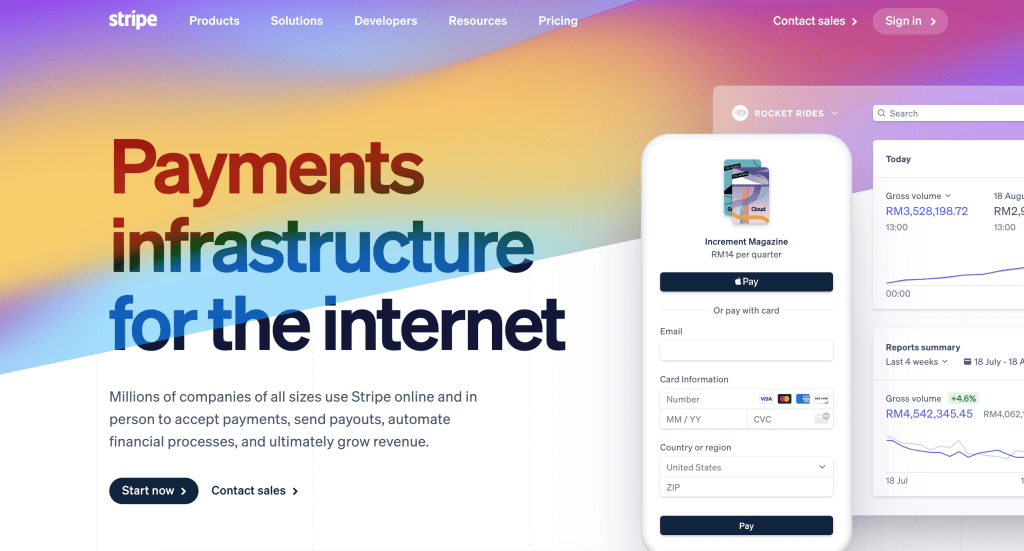
You can integrate multiple payment gateways can provide flexibility for your customers and reduce the risk of losing sales due to payment method limitations. Additionally, consider the preferences of your target audience. Some may prefer traditional credit card payments, while others may opt for digital wallets or alternative payment methods.
Ensure Secure Transactions
Security is a top priority in online transactions. You must implement Secure Sockets Layer (SSL) certificates on your website to encrypt data transmitted between your customers and the server. This encryption protects sensitive information such as credit card details, enhancing the overall security of your dropshipping business.
Besides, display trust badges, such as those from payment processors or security providers, prominently on your site to reassure customers about the safety of their transactions.
Set Up a Transparent Pricing Structure
Clearly communicate all costs associated with the purchasing process to avoid surprises for your customers. This includes product prices, shipping fees, and any taxes or additional charges. Transparency builds trust, and customers are more likely to complete a transaction when they have a clear understanding of the total cost.
Additionally, be transparent about your refund and return policies to further instill confidence in your dropshipping business.
Integrate E-commerce Platforms
If you’re using an e-commerce platform like Shopify, WooCommerce, or BigCommerce, take advantage of their built-in payment integrations. These platforms often support a variety of payment gateways and streamline the setup process.
Many of them also offer customizable checkout pages, allowing you to maintain a cohesive brand experience. However, ensure that your chosen platform complies with Payment Card Industry Data Security Standard (PCI DSS) requirements to guarantee the security of customer payment information.
Test and Test
Before launching your dropshipping business, thoroughly test the entire payment process to identify and rectify any issues. This includes testing different payment methods, ensuring a smooth checkout experience, and confirming that payment gateways are functioning correctly.
Monitor transaction success rates and address any obstacles that customers may encounter during the payment process. Regularly review your payment options and stay informed about emerging technologies and trends to adapt and optimize your payment strategy over time.
6. Market Your Dropshipping Business – Start a Dropshipping Business
Marketing is a fundamental aspect of building a successful dropshipping business. It plays a pivotal role in attracting customers, generating sales, and establishing your brand. Here’s a comprehensive guide on how to effectively market your dropshipping business.
Develop a Strong Brand Identity
Building a memorable brand is essential for differentiating your dropshipping business in a crowded market. Start by creating a distinctive logo, choosing a consistent colour palette, and defining your brand voice. These elements contribute to a cohesive and recognizable brand identity.
Incorporate your brand into all aspects of your business, from your online store design to your product packaging. A strong brand not only attracts customers but also fosters trust and loyalty.
Utilize Social Media Marketing
Social media platforms are powerful tools for promoting your dropshipping business and engaging with potential customers. Identify the platforms where your target audience is most active, whether it’s Instagram, Facebook, Pinterest, or others, and create compelling content.

You may leverage visually appealing images, videos, and infographics to showcase your products. Engage with your audience through comments, direct messages, and polls to build a community around your brand. Also, consider running targeted social media ads to reach a broader audience and drive traffic to your online store.
Implement Influencer Marketing
Collaborating with influencers in your niche can significantly boost your dropshipping business’s visibility. You need to identify influencers whose audience aligns with your target market and reach out to them for potential partnerships.
Influencers can create authentic content featuring your products, reaching their followers with recommendations. This not only introduces your brand to a wider audience. Instead, you can leverage the trust that influencers have already established with their followers. Also, you should ensure that collaborations feel genuine and align with both your brand and the influencer’s personal style.
Optimize for Search Engines (SEO)
Investing in search engine optimization (SEO) is crucial for improving the visibility of your dropshipping business on search engines like Google. Firstly, you need to conduct keyword research to identify relevant terms in your niche. Then, incorporate them into your product descriptions, blog content, and meta tags strategically.
You can create a blog on your website to provide valuable content related to your products and industry. By updating your content regularly and focusing on building high-quality backlinks to improve your website’s authority. Effective SEO practices increase the likelihood of your online store ranking higher in search results, driving organic traffic to your website.
Leverage Email Marketing
Building and nurturing an email list is a powerful way to connect with potential customers and drive repeat business. You should encourage visitors to subscribe to your newsletter by offering discounts, exclusive content, or early access to promotions.

Then, develop targeted email campaigns that showcase your products, share valuable content, and communicate special offers. Besides, you should also personalize your emails based on customer behaviour and preferences to enhance engagement. Email marketing allows you to maintain a direct line of communication with your audience and can be a valuable tool for building lasting customer relationships.
7. Optimize it
Testing and optimizing your dropshipping business is a continuous and essential process to ensure long-term success and growth. It involves systematically evaluating various aspects of your operations and strategies to identify areas for improvement and capitalize on what’s working well.
Product Performance Testing
Regularly assesses the performance of your product offerings by analyzing sales data, customer feedback, and order fulfillment metrics. Identify your best-selling products and understand the factors contributing to their success. Simultaneously, scrutinize underperforming items to determine whether they should be reevaluated or removed from your catalogue.
A/B testing different product descriptions, images, or pricing strategies can provide valuable insights into what resonates best with your target audience. By staying attuned to product performance, you can optimize your inventory, enhance customer satisfaction, and maximize overall sales.
Marketing Strategy Optimization
Evaluate the effectiveness of your marketing efforts by analyzing key performance indicators (KPIs) such as conversion rates, click-through rates, and return on investment (ROI). You should test different marketing channels, campaigns, and messaging to identify what resonates most with your audience.
To do this, you can leverage on analytics tools, such as Google Analytics or social media insights, to track user behaviour and adjust your strategy accordingly. You can explore new marketing trends and technologies to stay ahead of the curve. By refining your approach regularly based on the data, you can ensure that your marketing efforts align with your business goals and provide the best possible return on investment. Continuous testing and optimization of your marketing strategy will keep your dropshipping business adaptable and competitive in the ever-evolving e-commerce landscape.
Final Thoughts: How to Start a Dropshipping Business in 7 Easy Steps
Starting a dropshipping business is not just about finding the right products but also about crafting a unique brand, understanding your market, and continuously adapting to the evolving dynamics of online retail.
Whether you’re a seasoned entrepreneur or a newcomer to the business world, the insights shared in this guide are designed to empower you with the knowledge and tools needed to build a robust and sustainable dropshipping venture. As you set forth into online commerce, may your business flourish, and may you find fulfillment in the entrepreneurial journey you’ve chosen.





